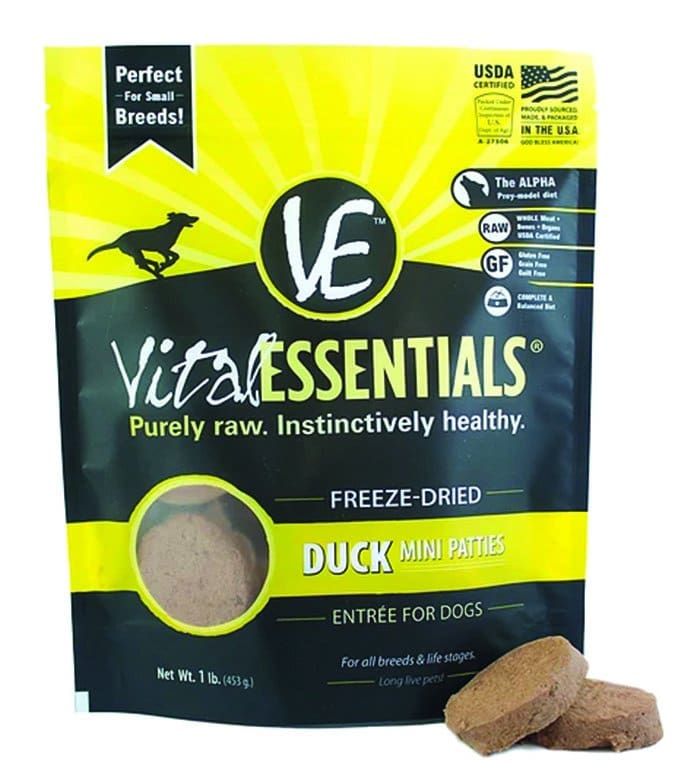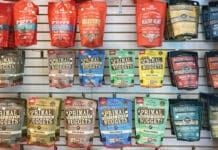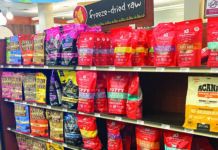Are you looking for the most expensive way to feed your dog? Probably not – but if price is no object, the freeze-dried dog food products we’ll describe here are very high-quality foods that are extremely shelf-stable (in many cases, without the use of any preservative, or with a natural preservative only). Many are made with organic ingredients; many are made with certified humanely raised and/or grass-fed meats. All of the freeze-dried dog food diets are made with a high inclusion of meat; some contain as much as 95 percent animal muscle meat, organ meat, and raw ground bone.
Most of the other ingredients in freeze-dried dog food diets are raw and/or very lightly processed. All the freeze-dried raw diets we reviewed are grain-free – not because we think grains are inappropriate in these foods; it’s the food manufacturers who seem to have decided that raw feeders won’t buy a product that contains any grain.
Many people who feed home-prepared or commercial raw diets to their dogs when they are home replace this diet with a freeze-dried raw food when they travel, or when the dog is left with a sitter who doesn’t want to deal with a fresh or frozen raw diet.
Benefits of Freeze-Dried Dog Food
In addition to being raw and lightly processed, freeze-dried dog diets offer other benefits:
1. Freeze-dried food stores longer than kibble.
Very low-moisture foods such as these products can be stored at room temperature (in unopened packages) without spoilage or rancidity – much longer than kibble. That’s because most freeze-dried diets contain about three to five percent moisture; conventional kibble generally contains about 10 percent moisture. The less moisture there is in a food, the less biological activity can occur.
2. Dogs love the taste of freeze-dried raw food.
When rehydrated, these foods are highly palatable to most dogs. It may be due to the concentration of flavor in freeze-dried food ingredients or their minimal processing. Dogs with poor appetites (like very senior or chronically ill dogs) may accept these foods when nothing else appeals.
3. Really good ingredients in freeze-dried dog food.
As a generalization, the makers of these freeze-dried dog food products are targeting the top end of the market and have an extraordinary commitment to sourcing top-quality ingredients.

Raw Freeze-Dried Dog Food is Still Raw Dog Food
Though it should be obvious, it bears repeating that all of the products included in this review are made with freeze-dried raw meats. Raw diets aren’t for every dog or owner. Cooked foods may be safer for immune-compromised individuals. Some dogs digest cooked foods better.

That said, freeze-dried dog foods don’t seem as “raw” as raw-frozen or fresh raw foods, but it’s important to understand that they are, in fact, uncooked. Freeze-drying removes so much moisture from the ingredients that it stops the biological action (decay) in the food, with less damage to the meat’s natural enzymes or vitamins than cooking temperatures cause. When the foods are rehydrated, the biological activity of any pathogenic bacteria that might be present in the food can resume.
The Food Safety Modernization Act (FSMA) of 2011 contains zero-tolerance policies for products that test positive for pathogenic bacteria. For this reason, some of the manufacturers of freeze-dried raw foods subject their products to a “kill step” known as high-pressure processing (also known as high-pressure pasteurization, and in any case abbreviated as HPP); they don’t want to risk increased surveillance or recalls from food control officials.

The owners of some companies, however, believe so strongly in the benefits of raw foods, that they refuse to use a kill step. Instead, they rely on the quality of their ingredients and their own food “hazard analysis and critical control points”(HACCP) plans to prevent selling contaminated products. They understand that the FSMA policies are present to protect dogs and their owners, and that today’s human food supply does sometimes contain pathogens – but they also have observed that most healthy dogs can thrive on raw foods that may contain some pathogens (few healthy dogs have trouble with Salmonella, for example, though Listeria and e. Coli are another story). And, importantly, they engage and educate their consumers about these facts.
There are food-industry experts who feel strongly that HPP is a very safe technology, and others who worry that it may alter foods on a molecular level. We feel fine about HPP; we’ve been to HPP plants and observed the raw dog food before, during, and after treatment and have confidence that it is not harmed or made unsafe to feed. On the other hand, we respect the right of owners to feed raw foods that have not undergone a kill step – as long as they are informed about the risks to which they are subjecting themselves and their dogs.
Some of the companies utilize a “test and hold” program whereby finished products are tested for pathogens and not released for sale until results indicate the products are uncontaminated.
Varieties of Freeze-Dried Dog Food
The freeze-dried foods on the market are diverse in content, appearance, and form. Some are very high in protein and fat – there are even products that contain more fat than protein! – while others compare in these respects to high-end kibble. Always check the guaranteed analysis when switching to a product in this category, particularly when feeding a dog who needs to be on a lower-fat diet.
Most of these freeze-dried dog food products are meant to be rehydrated with water before serving, though the products that come in small cubes can be fed as treats without rehydrating. In general, though, adding water will bulk up the food, making it more filling for your dog, as well as easier to digest.
Some of the freeze-dried dog food products are very powdery, which makes them turn into a sort of mush (or gruel, depending on how much water you add) when rehydrated. Some are powdery with large chunks of identifiable dehydrated meats, fruit, and/or vegetables – either an advantage (if your dog enjoys the contrast in taste and mouth-feel) or a disadvantage (if your dog seeks out only the chunks or mush and eschews the other).
Typical Freeze-Dried Dog Food Ingredients
On the table that starts on the next page, we have listed the ingredients for one variety of each company’s food. When a chicken variety was available, we used the ingredients of that variety, so you could compare relatively similar product offerings.
The Price of Freeze-Dried Dog Food
We’ve listed prices for the largest size of the products that are available; the larger sizes are generally the most economical (if that can be said at all of this category).
Because the cost of these products is so high, we imagine that few people feed them full-time, especially if their dogs are large or many. We would most likely use them only for a small dog, on a short-term basis while traveling, as training treats, to jump-start the recovery of a sick dog, or to extend the life of a chronically ill dog.
SUBSCRIBERS ONLY: Click here to see Whole Dog Journal’s list of approved freeze-dried and dehydrated dog foods.







I was concerned about the stated high protein and fat on Stella and Chewy freeze dried. I contacted S&T and they indicated that the Protein and Fat content on the package was for the dried. Once rehydrated the food had a significantly lower protein and fat %. See S&C response below …
Product Analysis:
Guaranteed Analysis:
Crude Protein (min.)
48.0%
Crude Fat (min.)
28.0%
Crude Fiber (max.)
5.0%
Moisture (max.)
5.0%
—————————————-
Rehydrated Analysis:
Crude Protein (min.)
15.0%
Crude Fat (min.)
9.0%
Crude Fiber (max.)
2.0%
Moisture (max.)
72.0%
Well, yes… If you add water to something, the total percentage of what’s in a cup of it will contain less of everything that is NOT water. The question is, do you add water to the diet? Many of us use this diet as training treats, without adding water.
Keep in mind that if you want to compare the total fat and protein of a dry food (@10% moisture) to a dehydrated food @5% moisture) to a rehydrated food (depends on how much water you add) to a canned food (@70-80% moisture), you should calculate the “dry matter” percentages of each. When you do so, you will see that on a dry matter basis, these foods are still high in fat and protein.
man!, the confusion!, one must become a geek freak… to understand what has been done naturally for thousands if not millions of years. …and the data is fed in as many unit forms as can be mustered up, oz, cups, pounds, 1/x pounds… wtf!! why not exposing it as nano-grams while you’re at it!
As usual the price becomes prohibitive.
So, the only way one can work thru this standard industries cover-up is to gather the data and place it in a spreadsheet with all factors reduced to PHCKNG directly intelligible layman’s terms/values.
Everything in the bio-world is high water content 50% and above.
All dogs do not eat the same volume/weight per sitting/per day.
To make real life sense one must calculate/visualize while water is included. Yet all the data comes at the dry level!?
Taking a median value(72% hydration)… how much of each of these dried foods will equate to a natural volume/quality amount!?
…and if the food is 5% hydration, what does 72% hydration really mean!? a 77% blob of pasty mashed-potato-choke-me-dry-gulp-gulp-multiple trips-to-the-water-pail-as-I-try-to-down-this-sweat-soakin’-concoction!?
They say, any pellet food is ok as long as you add the $1.27 powder scoop of vital ingredients to the daily intake of the hapless doggy!
One bag of that food %40.00 per month, + 1 jar of powder $1.27 per day() or $40.00, and promptly doggy food cost is doubled. …and the poison(s) mentioned in the original shite are still present! So, sell me shite and then a shite-fixer to fix the original shite. The stench seems to remain strong, while some greedy bastard vet rolls in millions!
What a scam!
In the days of farms, lonnnnng long ago there were a structure that was conducive to a family setting, including pets, and it worked quite well… the modern world has changed the structure while it lags behind in putting in place proper safe, thoughtful technology to match the natural order, free of profiteers who cut corners and lie about it.
If a puppy cost a $million a life-time to feed there would be 3 pets in the world!
Thank you for the article, it a least brings some info to the debate.
Which of above freeze dried food contain NO additives.
Thanks
I noticed that Orijin Freeze Dried Raw Tundra was not included. Because I keep my dog away from chicken, beef and Turkey due to possible allergies, I have consistently used Tundra. I’m wondering why it wasn’t included. Also, I recently added Open Farm Freeze Dried Lamb (also not included). I have one 20lb dog and price is not an issue. I just want him to have the best food available for him. Because he is a rescue I’m not sure of his age, but my vet and I suspect he is around 8 or 9 years old. I really need direction.
I didn’t find the first 4 of these to be online stores, but I’m still visiting the list. Distance is an issue. Shipping is ideal.
– ‘Respect2Glory’ almost everywhere.
Nancy,
Great article, thank you, very thorough and confused, you’re a great writer! I would like to know which companies practice the “test and hold” method you mentioned? I don’t want it pasteurized, but I also want safety. Test & hold wound perfect!
Bugler, love the argument. I’d love to know which essential toppers you would recommend!
Nancy,
Great article, thank you, very thorough and concised*, you’re a great writer! I would like to know which companies practice the “test and hold” method you mentioned? I don’t want it pasteurized, but I also want safety. Test & hold wound perfect!
Bugler, love the argument. I’d love to know which essential toppers you would recommend!
Nancy,
Great article, thank you, very thorough and concised*, you’re a great writer! I would like to know which companies practice the “test and hold” method you mentioned? I don’t want it pasteurized, but I also want safety. Test & hold sounds perfect!
Bugler, love the argument. I’d love to know which essential toppers you would recommend!
Nancy,
Great article, thank you, very thorough and concised*, you’re a great writer! I would like to know which companies practice the “test and hold” method you mentioned? I don’t want it pasteurized, but I also want safety. Test & hold sounds perfect!
Bugler, love the argument. I’d love to know which essential toppers you would recommend!
It seems all the pet stores near me and so many internet sites are recommending feeding at least a percentage of raw food so although the word “raw” (i’m giving my age away) sends shivers up my spine, I am thinking of trying one of these for my dogs (this whole DCM thing keeps me up at night). Anyway, the high protein and fat levels concern me as my dogs are six years old and are thus approaching senior hood, Are these appropriate for older dogs?
I have added I and you and Love to our rescues grain free kibble. Would like to know if this freeze dried raw food is a good quality for our beloved pets.
What about Dr. Marty’s product? It is dried freeze and I saw the whole ads. It was produced by only one Canadian vendor , which was only willing to provide human grade products with non by product, organic, non GMO, non- additive and etc. It sounds quite high standard. My dog, 2 -year -old havanese, keeps licking his paws, it became so red, losing hair.
I have been looking for better food in case he has an allergy on food. I feel like it is a bit from chicken though.
I haven’t found any report on Dr. Marty’s Raw freeze-dried Dog food (except from Dr. Marty’s site), and my 16 lb. Shih Tzu seems to really like it, and it sounds logically good for her. Our vet recommended us looking at an approved list of dog foods at the AAFCO site, but AAFCO doesn’t CREATE a list of approved dog foods. Hmmm…?
I to would like to know about Dr.Marty’s. I have a 5lb chihuahua and was looking for a better food that we can afford. I bought it and she seems to like it. I feed it dry with her kibble. It would be nice to know where it rates and pros and cons to it.
I am having a hard time understanding your list. Are you only recommending 4 brands? Or, are the ones that follow also recommended? I have never seen an author reply to ANY of the questions in your comments. section. And, while I subscribe to your website for up to date guidance, I may have to reconsider given that it appears that you do not monitor or answer relevant comments and questions. With hopes that you will reply to this question!
Is Dr Goldstein’s freeze dried dog food better than other freeze-dried dog food brands?
I just purchase Dr Marty’s raw freeze dried food for my dog. I notice it wasn’t on your list. How would you rate it? Also , can dogs get worms from this kid of food?
Yes, please comment on Dr. Marty’s!
This article, although you tried your best, is confusing. My dog is on a home-made diet of fresh chicken or beef, sometimes with egg, and krill oil. HerPekingese cost and energy are great, but it’s a hassle and expensive. Did you check out Dr. Marty’s?
Hi, when will WDJ do an updated review on freeze-dried raw? This review was done in 2018, quite a few years back….
I recently switched to freeze dried from home cooked (using a diet formulator).
I found that very few companies provide complete nutrient profiles, i.e. listing exact amounts of nutrients and minerals, which is disappointing.
Based upon this factor alone I was able to narrow down my choices to three companies.
I use Tuft’s Pet Food Calculator to determine how much of a particular nutrient my dog gets from the food in 100 calories.
If you have a small dog or cat that eats few calories this calculator is especially useful as you maybe surprised to learn that some nutrients are listed as present in the diet but at 100 calories are non existent.
Using this calculator helped me determine that some of the formulas did not contain enough of certain nutrients (B12, Folate, Iodine).
This helped me narrow not only the manufacturers but the individual formulas as well.
That said, for the cost of freeze dried products I believe consumers should have access to full nutrient profiles. Not just a list of ingredients and guaranteed analysis. That’s a “take our word for it” practice.
Even Tufts University Clinical Nutrition Service states “Remember, if the company can’t or won’t give you this information, it should be a red flag and you probably don’t want to feed that food to your pet”.
Id like any comments about Dr Martys food since I ordered it already. Seems to be very expensive.
I find it amazing that people are concerned that a dog would eat raw food. Abs that abs old dog might get too much fat or protein. Horse about a wolf, do they cool there food, or not eat fast and protein when they get older?
Feed your dog raw food from the store, freeze the fish first to ensure any parasites are dead. Raw beef is eaten by humans as a delicacy in other countries so your dog can probably handle that too. I only eat grass fed beef and ocean caught fish so that’s what my dog eats. Organic veggies, Squash, carrots, pumpkins, zucchini.
I am a member of WDJ – many years now. My question is about ZIWI dog food. I have been feeding this to my dachshund in the AM’s for several years. He eats small amounts, but NOW I see that the jerky pieces are half the size they were 2 months ago, and too that ZIWI is now owned by China. Is ZIWI safe to feed my pet? I am very concerned. This is January 2024.